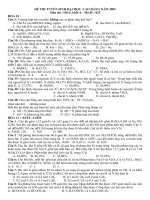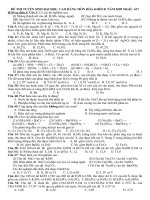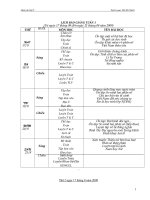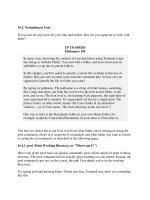minerals (2) minerals in geology
Bạn đang xem bản rút gọn của tài liệu. Xem và tải ngay bản đầy đủ của tài liệu tại đây (967.77 KB, 28 trang )
Introduction to Minerals
Professor Jeffery Seitz
Department of Earth & Environmental Sciences
California State University East Bay
•
•
•
•
Introduction and Definitions
Chemical Classification
Diagnostic Properties
Some Common Minerals
1
The word mineral is used in a variety of ways.
any valuable material extracted from the Earth like coal, gravel, and
even groundwater.
by nutritionists for elements metabolized by the body
as anything that isn’t animal or plant
Over 4,000 minerals have been identified in the scientific literature Approximately 40 - 50 new ones are discovered every year!
Luckily, there are relatively few (10-15) common rock-forming
minerals.
DEFINITIONS
A rock is any solid mass of mineral (or mineral-like) matter that occurs
naturally. A few rocks may be composed of only one mineral, but
most are an aggregate of several minerals.
A mineral is any naturally occurring inorganic solid that possesses an
orderly internal structure and a definite chemical composition.
•
•
•
•
•
naturally occurring (concrete, synthetic diamonds, etc. are excluded).
inorganic (teeth, seashells, trees, etc. are excluded)
solid (gases and liquids are excluded)
orderly internal structure (amorphous solids like glass are excluded)
definite chemical composition
examples: C Diamond
NaCl Halite
(Na,Ca)Al(Si,Al)Si2O8 Plagioclase
One way that rocks are characterized is by their mineral content.
For example, the rock granite commonly contains the three minerals:
•quartz
•feldspar
•biotite
Luckily, most rocks are
composed of a few
common rock-forming
minerals.
quartz
feldspar
biotite
Wikipedia contributor: Benjah-bmm27
Part of the definition of a mineral is that it has
an orderly internal structure, i.e. crystal
structure.
The top image shows the crystal structure of
halite (common table salt) NaCl (Na = purple,
Cl = green).
The bottom image shows a halite crystal.
It is clear that the crystal structure of a mineral
may control important mineral properties such
as its form (crystal shape) and cleavage.
mindat.org
Some materials are mineral-like but lack
crystal structure and are known as mineraloids
(ex. amber, obsidian, etc.)
5
Part of the definition of a mineral is that minerals have a definite
chemical composition.
The composition or chemistry of a mineral is an important property that
may control geologic process such as weathering, melting,
metamorphism, etc.
Some minerals have a simple chemical formula
examples: diamond C
halite NaCl
quartz SiO2
Other minerals have chemical formulas that vary between very specific
limits. This is because some elements are similar and may substitute
for others within the crystal structure.
examples: plagioclase (Na,Ca)Al(Si,Al)Si2O8
olivine (Mg,Fe)2SiO4
6
jewelsmiths.com
Question
Graphite and diamond are pure carbon have
the same chemical formula:
C
But,
diamond is the hardest substance know
and,
graphite is one of the softest minerals.
If they have the same chemical formula,
why are they different minerals?
7
Chemical Classification of Minerals
Minerals are classified based on their (anion) chemistry:
•minerals that contain silica (SiO2) are silicates ex. quartz SiO2
•minerals that contain carbonate (CO32-) are carbonate ex. calcite CaCO3
•minerals that contain sulfur (S) are sulfides ex. pyrite FeS2
•minerals that contain oxygen (O) are oxides ex. magnetite Fe3O4
Silicates are the most common minerals and the properties of silicate
minerals significantly control geologic processes. For example,
•silica-rich minerals tend to melt a
lower temperatures than silica-poor
minerals
•silica-rich minerals are the last to
crystallize from a magma relative to
silica-poor minerals
•silica-rich minerals tend to be more
resistant to chemical weathering than
silica-poor minerals
silica-rich feldspar
silica-poor olivine
8
Diagnostic Properties of Minerals
Minerals may be identified by different physical and chemical
properties. It is important to understand that a minerals is usually
identified by a variety of properties. No single property is diagnostic
for all minerals. Common diagnostic properties include:
•Color
•Streak
•Luster
•Hardness
Other properties that may be diagnostic for a mineral may include:
•Crystal form
•Cleavage/fracture
•Magnetism
•Reaction to acid
•Density
•Smell/Taste and many more.
Color
Color seems like an easy property but it is risky to identify a mineral
by its color alone.
Most minerals can have a wide range of colors due to small amounts of
impurities in them such as these examples of quartz.
Smokey Quartz
A methy st Quartz
Citrine Quartz
Another example, rubies and sapphires are the
same mineral, corundum, and have a wide
range of colors! So color alone is not very
diagnostic.
Rose Quartz
Corundum
Streak
A mineral’s streak is the color of a
powdered mineral on a streak plate
(unglazed porcelain tile).
This property can be diagnostic for
a small number of minerals
(usually those with a metallic
luster).
Although the color of a mineral
may vary, the color of the streak
remains surprisingly constant.
Luster
Luster describes the way that the
surface of the mineral reflects
light. There are many types of
lusters but the common ones are:
•Metallic
•Nonmetallic
•glassy
•brilliant
•dull
Hardness
Hardness is a mineral’s ability to
resist being scratched.
The Mohs hardness scale is a
unitless 10-point scale with each
hardness value represented by a
common mineral. The Mohs’
hardness scale is not linear!
Hardness can be directly related to
bond strength – hardness is an
expression of the weakest bond.
Compare the hardness of graphite
(H=1) and diamond (H=10); they
have the same chemical
composition but different
bonds/structures.
Crystal Form
Some minerals that grow without being impeded by their environment
develop characteristic crystal shapes or crystal form that represents the
symmetry of the crystal structure. Crystal form can be a diagnostic
property for some minerals.
Quartz has an internal structure
that has a 6-sided (hexagonal)
symmetry. As a result, quartz
crystals commonly are 6-sided.
Halite has an internal structure that
has a cubic (4-sided) symmetry. As
a result, halite crystals commonly
are cube shaped.
14
Cleavage
Cleavage is the tendency of
minerals to break parallel to
crystallographic planes along
which chemical bonds are weaker
than others.
Cleavage surfaces are not
necessarily parallel to crystal
faces.
It may be difficult to distinguish
between cleavage planes and
crystal faces.
biotite
albite
halite
calcite
fluorite
Fracture
Fracture is the way a mineral breaks in the absence of a cleavage
plane. In some crystals, the strength of bonds is approximately equal
in all crystallographic directions. Several types of fracture can be
described:
conchoidal – smooth curved surfaces resembling shells
fibrous – common with asbestos
hackly – jagged fractures with sharp edges
irregular or uneven – rough or irregular surfaces
Conchoidal fracture in
obsidian.
Fibrous fracture in
chrysotile.
Hackly fracture in native
copper.
Magnetism
Magnetism in minerals results from atomic
properties of certain metal atoms in minerals.
This property is diagnostic for a few minerals
such as magnetite.
Reaction to Acid
Minerals that contain the chemical
component carbonate (CO32-) react to
acid by effervescing.
The mineral calcite effervesces by
the reaction:
CaCO3 + 2HCl —>
CO2 + Ca2+ + 2Cl- + H2O
Other Properties
There are many other physical properties
that may be diagnostic for some minerals.
•Play of color
•Smell/Taste
•Luminescence
It is important to understand that not all
properties are diagnostic for all minerals.
asterism
Let’s look at
some
minerals.
Quartz SiO 2
Quartz is a silicate mineral and is the second most
common mineral in the Earth’s crust.
It is usually white or colorless but has a wide range
of colors; some of its colored varieties are semiprecious gems such as amethyst and citrine.
Quartz is used to make glass and computer chips.
Quartz commonly forms nicely shaped 6-sided
crystals that are widely available.
Quartz is common in igneous and metamorphic
rocks. It is resistant to chemical weathering and is a
common constituent of sediments such as sand and
sedimentary rocks because it is resistant to
weathering.
Feldspar NaAlSi 3 O8 - CaAl 2 Si 2 O8 KAlSi 3 O8
Feldspar is a large, complex family of silicate minerals
and is the most common mineral in the Earth’s crust.
Since it has a wide range of chemical compositions, its
appearance may also vary widely.
Feldspar is commonly white to dark gray in color.
Some common
varieties
Feldspars
are used
in the are pink.
manufacturing of specialized glasses
and ceramics. It is commonly used in
aggregate and, because it is so
common, is commonly used in
construction (building facing, etc.).
Pyrite FeS 2
Pyrite is a sulfide mineral and is one of the most
common of the minerals with metallic luster. It is
also known as “fool’s gold.”
Although it usually forms massive groups of
indistinct crystals, it may also form beautifully
formed cubic and soccer ball-shaped crystals.
It also commonly replaces organic material and
forms fossils.
It has no economic importance now, but in the
past, it was an important source of iron and sulfur.
Magnetite Fe 3 O4
Magnetite is an oxide mineral and is a
common iron ore mineral.
It is usually black in color and has a
black streak. Its luster is commonly
metallic but may appear submetallic.
Magnetite forms massive groups of
small indistinct crystals, but may
rarely form octahedral crystals.
The most distinguishing property of
magnetite is that it is magnetic.
Talc Mg 2 Si 4 O10 (OH) 2
Talc is a silicate mineral and is commonly
found in metamorphic rocks.
Although it is not a very common mineral,
it is a good one to show to students because
of its very low hardness. The extreme
softness of the mineral gives it a slippery
feel.
It is usually white to light green in color
and may exhibit one-direction of cleavage.
Its nonmetallic luster may appear glassy to
pearly in appearance.
Talc is used as an industrial lubricant, as a
filler in paints and plastic and commonly as
a major ingredient in talcum powder and
cosmetics.
Mica
Muscovite KAl 2 (Si 3 O 10 )(OH,F,Cl) 2
Biotite K(Fe,Mg) 3 AlSi 3 O 10 (OH) 2
Muscovite and biotite are silicates and are
two of the most common types of mica.
The micas are a complex group of
minerals that are characterized by
excellent cleavage in one direction - thus,
it can be split into thin flexible sheets.
Muscovite and biotite can be distinguished
from one another by color: muscovite is
clear to tan-brown and biotite is dark
brown to black.
The hardness of the micas ranges 2-3.









